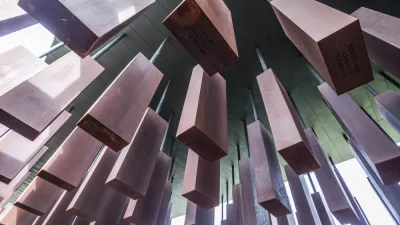Michael Arad's winning design for the Ground Zero memorial must overcome considerable political, administrative and financial hurdles if it is ever to be constructed.
"Winning the [Ground Zero memorial] competition was an extraordinary honour for [Michael] Arad. These days, however, it's a matter every day of defending his still unbuilt design, called Reflecting Absence, against the colossal forces waging war at Ground Zero. Arad needs to defend his design because, apart from Mayor Michael Bloomberg who declared last week that the memorial must be accomplished in time for the 10th anniversary of the 9/11 attacks, few people are up to the task.
The Lower Manhattan Development Corp., an agency that has steadily lost its vision and purpose over the last seven years, is to be dismantled, if Bloomberg has his way. And the Port Authority of New York and New Jersey is seen to be an administration incapable of getting consensus on how to build greatness into the 16 acres of devastated land.
Besides all of that, it's now estimated that the memorial and interpretive museum together could cost as much as $1-billion (U.S.) to build, of which $350-million has been raised, so far, through private donations. With the bottom falling out of the American economy, estimates that about $40-million would then also have to be spent annually on the maintenance and security of the memorial and its museum are surely alarming."
FULL STORY: A vision of grief's depths: Will it be built?

Maui's Vacation Rental Debate Turns Ugly
Verbal attacks, misinformation campaigns and fistfights plague a high-stakes debate to convert thousands of vacation rentals into long-term housing.

Planetizen Federal Action Tracker
A weekly monitor of how Trump’s orders and actions are impacting planners and planning in America.

Chicago’s Ghost Rails
Just beneath the surface of the modern city lie the remnants of its expansive early 20th-century streetcar system.

Bend, Oregon Zoning Reforms Prioritize Small-Scale Housing
The city altered its zoning code to allow multi-family housing and eliminated parking mandates citywide.

Amtrak Cutting Jobs, Funding to High-Speed Rail
The agency plans to cut 10 percent of its workforce and has confirmed it will not fund new high-speed rail projects.

LA Denies Basic Services to Unhoused Residents
The city has repeatedly failed to respond to requests for trash pickup at encampment sites, and eliminated a program that provided mobile showers and toilets.
Urban Design for Planners 1: Software Tools
This six-course series explores essential urban design concepts using open source software and equips planners with the tools they need to participate fully in the urban design process.
Planning for Universal Design
Learn the tools for implementing Universal Design in planning regulations.
planning NEXT
Appalachian Highlands Housing Partners
Mpact (founded as Rail~Volution)
City of Camden Redevelopment Agency
City of Astoria
City of Portland
City of Laramie



























